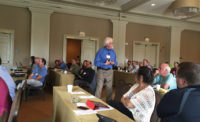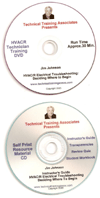Rick Blasgen, president and CEO of the Council of Supply Chain Management Professionals (CSCMP), spoke these words as he kicked off HARDI’s Operations and Logistics Optimization Focus Conference at the Wigwam Resort in Litchfield Park, Ariz. His presentation began with a historical look at the role of the supply chain and continued by centering on five current and future supply chain topics: Globalization, workforce issues, risk management and sustainability, big data, and e-commerce.
Though third on the list, Blasgen strongly emphasized the importance of risk management for distributors.
“Why is risk management so important?” he asked. “Consider the risks if you are sourcing from a geographical area. Asia is four times more likely to be affected by natural disasters than Africa and 25 times more likely than Europe or North America.”
The geographical consideration was included for more than natural disasters. According to Blasgen, real estate and the supply chain have become important partners, especially when considering the effect of new trucking regulations on trucking capacity. He urged distributors to maximize the use of full-load, low-cost, long-haul transportation and to minimize the use of part-load, high-cost, short-haul transportation.
“Consider adding a distribution center along the way,” said Blasgen. “The cost of transportation always supersedes the cost of warehousing.”
He noted that examining the infrastructure of a distributor’s supply chain and knowing the number of distribution centers, locations, configurations, speed, and flexibility, are important. Blasgen also reminded attendees that supply chain management is responsible for 8.5 percent of the United States’ gross domestic product.
“We improve the financial position of companies and economies,” he explained. “Our stature and credibility is increasing. Supply chain professionals need to develop cross functional skills and a global mindset to maximize the opportunities in the world.”
LOGISTICS MANAGEMENT
Managing the supply chain brings into question logistics. Ken Ackerman, noted supply chain author and editor of Warehousing Forum, a wholesale distribution e-newsletter, described logistics in its basest form as moving stuff. His presentation pushed further at this concept as Ackerman dove deeper into the shift of moving stuff from a, “competitive weapon to a survival necessity.”
His discussion took a look at companies like Amazon that are redefining service and raising the bar on customer expectations. This challenge is pushing wholesalers to measure logistics excellence, he said.
“How do you measure logistics excellence?” asked Ackerman. “The first thing to look at is the percent of total orders that are perfect orders. Then consider logistics costs as a percent of sales. This means your freight cost and your warehouse cost. You must build and maintain a reputation as a preferred shipper and measure handling productivity in the warehouse. Lastly, measure the inventory management order fill rate and maintain a product velocity profile.”
Along with logistics topics, he talked about raising the bar in warehousing quality. Ackerman’s four suggestions began with automatic identification — barcode or voice — to reduce errors. The second suggestion was controlling dock to stock time.
“Until the freight is in your computer, you can’t ship it,” he said. “Nobody is too small to have a good dock to stock time. It requires an advanced shipping notice and fairly rigid procedures of what to do once it is there.”
Ackerman’s third suggestion was for wholesalers to measure the percent of occupancy of their warehouse, and the fourth was controlling storage density and effective slotting.
“Blocking SKUs to get to others is the worst thing you can do in a warehouse when it pertains to productivity,” he explained.
BETTER BUYING INVESTMENTS
Mike Mills, vice president of education and professional development, and a Blue Ridge founder, instructed attendees how to turn their purchasers into investment buyers. Blue Ridge is a software company with its own inventory solution, but Mills’ presentation didn’t focus there, it focused instead on the ability to make more profit through better buying strategies. He delineated seven steps of buying for wholesalers to consider adopting as best practices.
- Demand forecasting. — Forecasting the customer.
- Lead time forecasting. — Forecasting the supplier.
- Order cycle optimization. — Finding the most profitable time to buy.
- Service level management. — This defines how often the wholesaler wants to be in stock. It also defines how often the wholesaler wants to be out of stock.
- Replenishment.
- Special order analysis.
- Order validity analysis. — Building orders to vendor restrictions.
Another key element Mills expressed was the need to have a unique amount of safety stock on all items. He warned that generic safety stock amounts and shooting from the hip can be dangerous to profit levels and goals.
“We have got to train our people to be investment buyers,” he ended. “They must learn to do an analysis and invest the company’s money wisely.”
CONFERENCE FEEDBACK
The mood was light during most of the sessions as well as the luncheon on the patio. It was a resort getaway that provided in depth supply chain logistics training information as well as a warm atmosphere for golf and outdoor networking.
This is the first time that HARDI offered this Focus Conference topic and feedback from attendees provided insight as to its value to the different types of members who participated.
“It’s extremely interesting. I really felt like there’s people back at our factory that would have benefitted immensely from this; and it has given me a new perspective looking at the operations and logistics at our company,” said Marcia Christiansen, PECO. “As a supplier, the networking for me is the largest component, but it’s also important that I understand the challenges that my customers are going through and as a side benefit, I learn things about our own business as well.”
Matthew McGarry of ABR Wholesalers Inc. in Rochester, N.Y., explained that the conference was not only enjoyable but that it was exceptional. In an interview with Distribution Center on the last day, McGarry praised the speakers that not only talked about logistics and operations, but that also touched on the purchasing side of the equation.
“One of the speakers said that, ‘Salesmen generate revenue, buyers generate profit.’ That really resonated with me,” he remembered. “Absolutely if you can send somebody or come yourself, it’s definitely well worth it.”
Although Embraco has been a supplier member for many years, Greg Hutchinson pointed out that he feels Embraco is like a new supplier member of HARDI.
“I know for a fact that our focus on the distribution market and customer base is greatly different than it has been in the past. It is very important for Embraco to be an active participant in the HARDI meeting and in HARDI as an organization, and I think we have been for the last three years — and will continue to be,” explained Hutchinson the company’s sales manager, North America, Aftermarket and Distribution division. “I think it is critical that manufacturers and wholesalers send the logistics/warehouse/inventory management person to attend, this is key. Same rule-of-thumb for the other focus conferences. That said, I do think that there is benefit for the sales guy to attend as well. Where else can you connect with so many of your customers in one place?”
The Marketing and Sales Optimization Conference in Delavan, Wis., June 22-24, is the next opportunity for HARDI members to participate.












